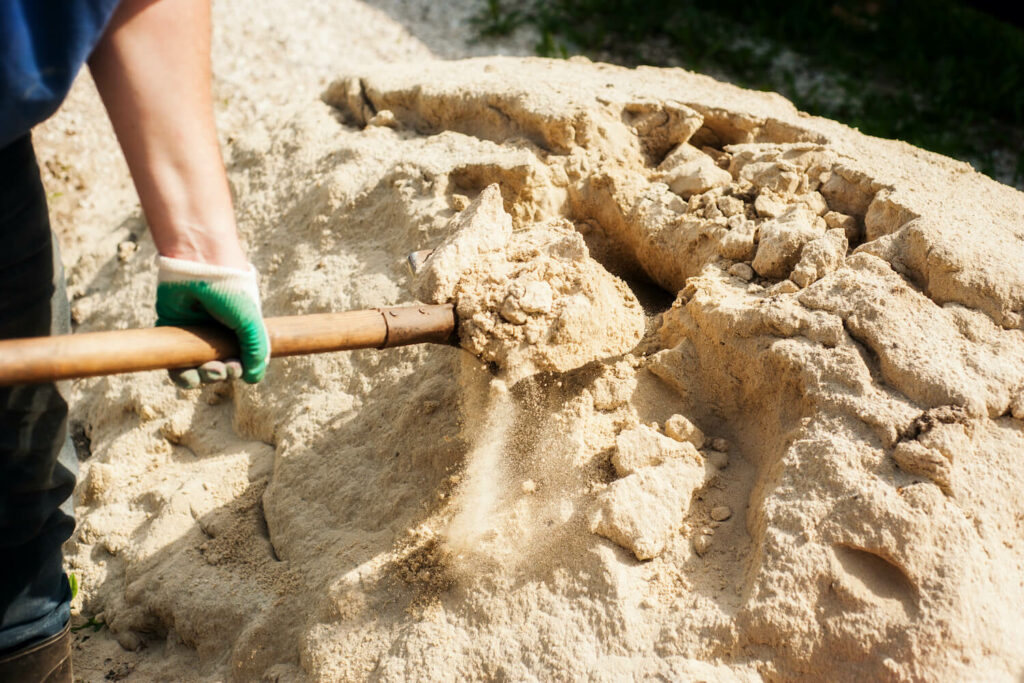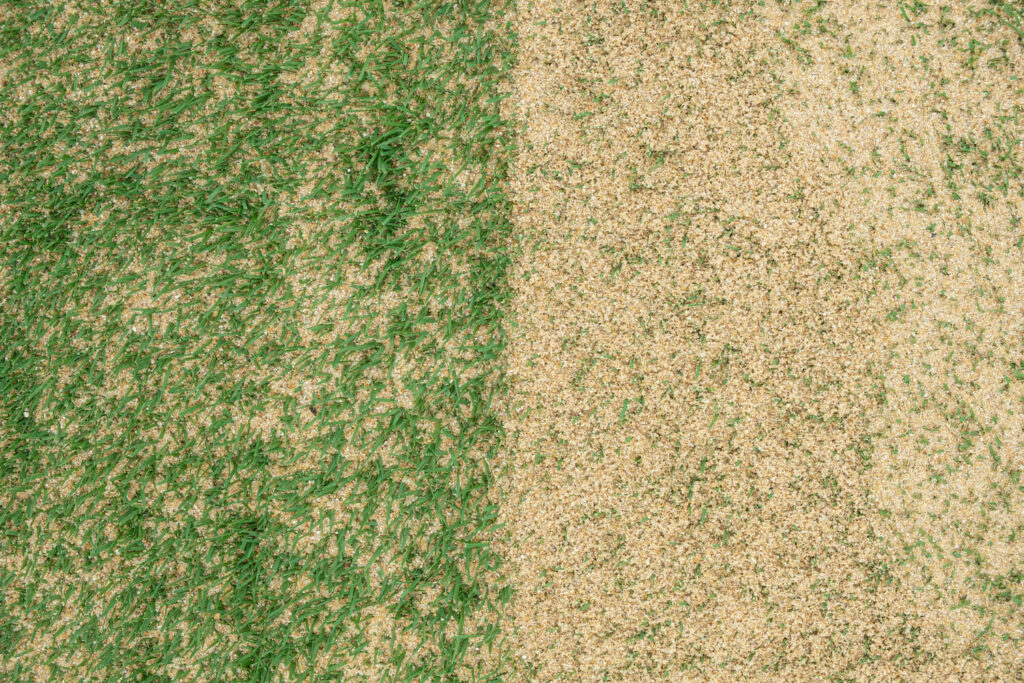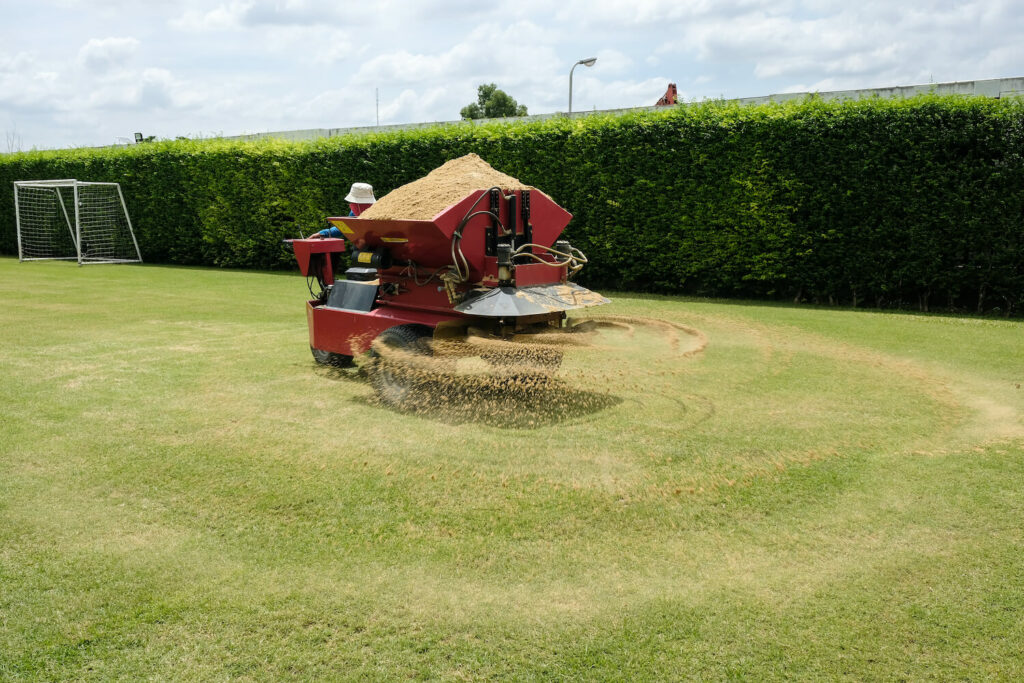I am a qualified gardener and horticulturalist and love everything that grows! Whether its a shrub, a tree, a useful plant or a supposed weed: for me, every plant is a little miracle. In the garden I look after my 13 chickens, grow fruit & vegetables and otherwise observe how nature manages and shapes itself. Favourite fruit: Blueberry, apple Favourite vegetables: Braised cucumber, kale, green pepper
Many questions arise when it comes to sanding lawns. Get answers to some of the most common questions about sanding lawns and tips on how to ensure that everything goes smoothly when topdressing with sand.
After scarifying and aerating comes sanding the lawn. Scarifying removes lawn thatch and stimulates the grasses to grow more densely. It also removes unwanted moss and opens the soil so that it is ready for fertilising and other maintenance measures. There are various tools you can use for lawn aeration, all of which aim to work the soil more deeply and improve its air and water flow. Sanding can be done independently of scarifying and aerating, but it is especially useful when done after these maintenance measures. It is a highly useful method for improving the growing conditions of your lawn, especially in compacted and clayey soils.
Sand can be a useful amendment for certain lawn and garden applications, but many homeowners make the mistake of over-applying it or using the wrong type. Understanding when and how to properly apply sand to your lawn is key to getting the benefits without causing harm.
When Sand Can Be Beneficial for Grass Seed
Applying a thin layer of sand can help grass seed germinate under certain circumstances:
-
To level low or uneven spots in the lawn before seeding. Sand can fill in dips and smooth bumps when applied sparingly. Be sure to use a lawn leveling rake to distribute evenly.
-
To cover newly seeded areas. A light sprinkling of sand over freshly planted grass seed can help retain moisture and protect the seeds.
-
In sandy soil. Grass seed germinates well in loose, sandy soils that allow good drainage and air circulation to the roots. Amending heavy clay soils with sand can create a better environment for seeding.
-
To topdress lawns with excessive thatch. Thatch is a tightly layered buildup of dead grass stems and roots. Applying a thin layer of sand can help break up thick thatch and allow seed to reach the soil.
-
For patch seeding bare spots Lightly raking bare patches before seeding and topping with a thin sand layer helps with moisture retention and seed-to-soil contact
When Not to Use Sand for Lawns
While sand has its uses it’s easy to overdo it. Some instances when sand should be avoided
-
As a standalone amendment for clay soils. Sand particles are too large to effectively break up sticky clay. Sand mixes poorly with clay and can create concrete-like soil.
-
As an annual topdressing. Yearly sand layers can smother grass and cause nutritional deficiencies by diluting organic matter and nutrients in the soil. Roots may struggle to grow through heavily sanded lawns.
-
Applied too thickly or unevenly. Excessive sand deix uneven lumps that are aesthetically unappealing. Grass can become buried and die underneath heavy mounds.
-
As filler for eroded areas. Sand does not contain organic matter to help rebuild eroded soils. The area will likely continue eroding. Use a mix of compost and topsoil instead.
-
Without checking soil composition. Sand may not be needed if your lawn already has a high percentage of sand particles. Having your soil tested can prevent unnecessary applications.
-
With the wrong sand type. Sand labeled for construction is too coarse. Play sand may be too fine and salty. Opt for horticultural grade “lawn sand”.
-
To lower soil pH. Sand is slightly acidic and frequent topdressing can lower soil pH over time and require frequent liming to neutralize acidity.
Best Practices for Using Sand on Lawns
If you’ve decided to use sand, follow these tips to minimize risks and get the most benefits:
-
Test soil composition first via jar soil texture test or lab analysis to determine current sand percentages.
-
Use only horticultural grade lawn sand, not construction sand, play sand, or beach sand. Lawn sand contains mainly silica with few impurities.
-
Apply only on an as-needed basis for spot leveling, seeding, and thatch problems. Do not topdress the entire lawn annually.
-
Spread sand extremely thinly, no more than 1/8 to 1/4 inches over the area. Excess sand can smother grass rather than help it.
-
Use a drop or lawn leveling rake to ensure maximum evenness and fill only the lowest spots.
-
Consider compost topdressing instead which provides organic matter, nutrients, and soil conditioning benefits versus sand.
-
After spreading, water the lawn lightly to help work sand down into the soil and grass canopy.
-
Monitor soil pH regularly and lime as needed to counteract acidification from sand.
-
Overseed after topdressing to fill any thin spots that develop and maintain turf density.
The key is applying sand judiciously only where needed rather than routinely. When used correctly, sand can provide certain benefits for establishing grass from seed, but the potential drawbacks make it important to exercise restraint. Test soil first, use sparingly, apply properly, and routinely monitor your lawn’s health.

Why is sand good for grass?
Sanding lawns has various beneficial effects depending on the pre-treatment (i.e. scarifying or aerating), the soil type, the sand you use and how much you apply. Even the equipment you use for distribution influences the effects of sanding your lawn.
The goals of sanding are:
- To improve aeration to promote root growth of the grasses
- To improve drainage and water run-off from to prevent waterlogging
- To increase resilience, especially to foot and vehicle traffic
- To increase strength of the soil, especially for lawns used for sporting activities
- To improve wettability of the subsoil and rapid drying of the lawn surface to prevent moss
- When evenly distributed, sand can also help with levelling a lawn

Essentially, if there are problems that severely impair your lawn’s growth, a large quantity of sand will improve the long term health of your lawn. However, regular sanding with small amounts also supports the growth of the lawn in the long run and significantly increases its resilience.
Tip: do not topdress naturally sandy soils with sand. Sandy soil naturally has a loose structure, so it has no problem with waterlogging or critical compaction.
Sanding a lawn: the right amount per square metre
How much sand you need for your lawn depends on your intentions:
- If the sand is used annually for levelling a lawn, as is typical for sports fields, use 0.5 – 1L of sand per m²
- When sanding after scarifying, use 2 – 3L of sand per m²
- After aerating with slitting blades, use 3 – 5L of sand per m²
- After using an aerifier with hollow cones, apply 4 – 6L of sand per m²
The actual amount of sand you should use also depends on your lawn’s soil type. Sanding is generally not necessary for soils that are already sandy. The more compacted or clay-rich a soil is, the more sand you should use to improve lawn drainage.

Sanding a lawn does not have to be difficult:
- With a sandspreader or a wheelbarrow, simply distribute a suitable amount of sand across your lawn. Heaps of sand are acceptable at this stage.
- After the initial distribution, spread the sand with the back of a rake and then more finely with the tines.
- Broom the sand in using a coarse push broom.
If the lawn needs levelling, pull a lawn levelling drag mat over the area several times. You may need to do this by hand if the mat is too small. There are also are lawn brushes that distribute sand evenly, but these are meant for larger trailing equipment and are not suitable for small private lawns.
Important: once the sand has been evenly distributed, you should be able to see the tips of the grass poking out of the sand across your lawn.

Should rolled turf be sanded?
Yes. Rolled turf does not differ in any way from seeded turf once it has grown in. Therefore, you can also sand turf. However, the first treatment should not be done until one year after installation. It may be necessary to spread sand before laying rolled turf to give the turf base layer more stability and better drainage.
The Best Sand For Lawn Leveling Is…
FAQ
Does sand help grass grow?
Basically, the only reasons to apply a layer of soil or sand to a lawn are to fill in low areas or bare areas, as a method of dealing with an identified thatch problem or possibly to cover surface tree roots. Topdressing your lawn with sand on a regular basis is not a recommended practice.
Will grass seed germinate on sand?
Yes, you can still grow grass on sandy soil! While sandy soil presents challenges, it also offers unique opportunities. Grasses that adapt well to well-draining soils can flourish in sandy environments.
What is the best thing to cover grass seed with?
Covering with polythene sheeting is a must on slopes! – It’s the best protection and insurance for your seed and hard work.
What is the best sand for grass seed?
Different sand grains and qualities can be used for sanding lawns. Dried sand is more free-flowing, while washed sand has been cleaned of dust or particularly coarse particles. For your home garden, it is best to use washed, pure quartz sand with a grain size of 0.06 to 2mm.
Is it possible to grow grass in sand?
Yes, growing grass in sand is possible. In fact, sandy soil is ideal for lawns as it drains quickly and prevents a muddy yard. To improve sandy soil, test it to determine what nutrients are missing and follow the necessary steps to amend it.
Is sand good for your lawn?
While sand isn’t the most effective way to deliver nutrients to your lawn’s soil, lawn treatments are. Your local garden center can help you with the right amendment, such as fertilizers or other top dressing mineral treatments, for your specific lawn.
Should I add sand to my lawn?
While adding sand gives a finished look to your freshly prepared turf, it also allows the easy mixing of grass seeds to level out and replant a lawn simultaneously. Seeds sowed in the sand are safe from wild animals, and the tiny sprouts are less likely to suffer from waterlogging and potential drowning.
Can sand be used for landscaping?
Sand can also be used as a water-repellent material. You can use it to add a layer of sand to your garden, or you can apply it directly to the soil. If you want to use sand for landscaping, make sure that the sand is not too fine or too coarse, and that it is well-drained. Does grass grow better in sand or soil? Can you plant grass seed over sand?
What kind of sand should I use on my lawn?
For general-purpose lawn sanding – to improve drainage and level the ground – use a chemical-free mix,” says Fiona Jenkins. “This is also best to use when you’re overseeding your lawn and on lawns used by pets and children. You can use a straight sand or a 70/30 sand and soil mix.
Does sand kill grass?
“However, if your lawn needs more help, a top-dressing sand with added nitrogen and iron can be used instead but do follow the instructions on the packet,” says Fiona. “Avoid using beach or building sand, as the chemicals or salt levels within these can kill the lawn,” adds Craig. Does sand make your grass grow better?
